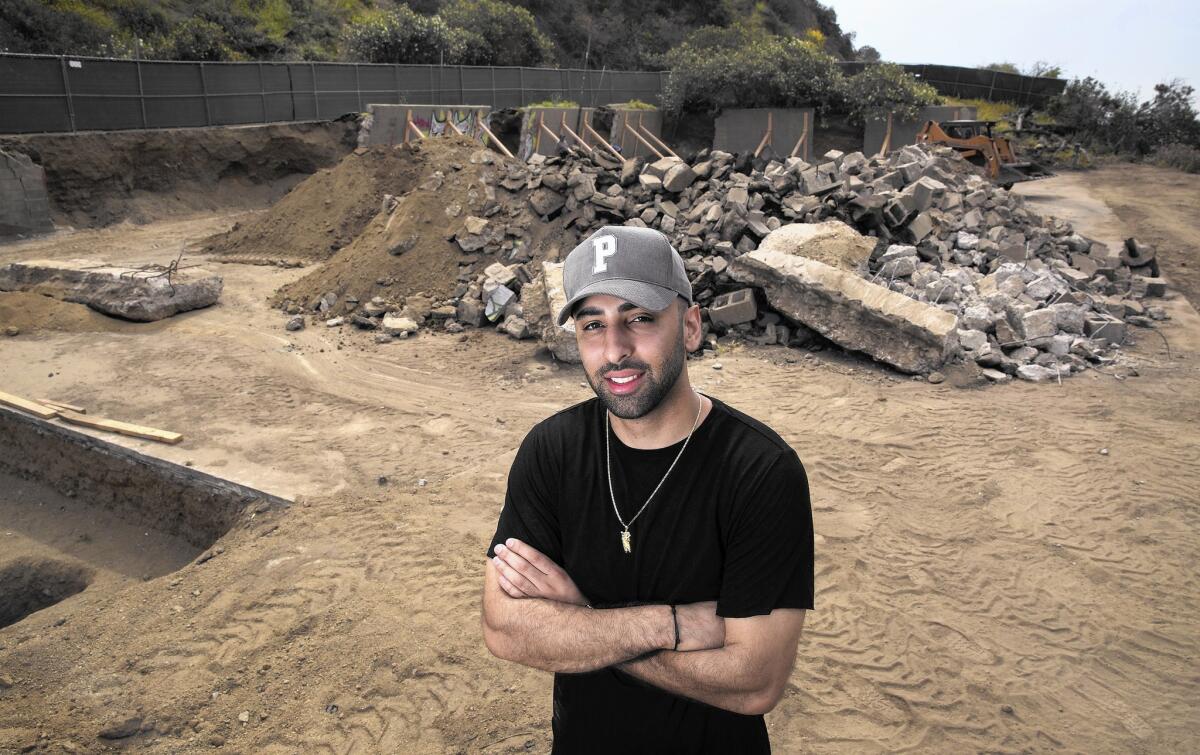Meet the man bringing a controversial basketball court to Runyon Canyon Park

- Share via
Thirty-five thousand people come to Runyon Canyon Park each week. Neima Khaila says he is just one of them.
The 28-year-old chief executive of Pink Dolphin, a Los Angeles company that sells limited-edition street wear, hikes or runs the park’s trails three or four times a week.
“It’s beautiful. It’s a great workout,” he said. “And the community, it’s really diverse — young people, old people, different races, different ethnicities.”
Khaila’s love of Runyon was what drove him, he said, to donate more than $250,000 to fix a problem. His money is paying for a new retaining wall above one trail. He is covering the cost of a basketball court. He thought fellow parkgoers would be pleased.

Runyon Canyon Park will be closed for four months.
Instead, he has found himself in the eye of a storm, the target of other Runyon regulars’ fury.
It all started with how news of his gift broke.
The announcement came shortly before the popular park closed for four months so leaking water pipes could be replaced. When people learned that a basketball court would be installed at the same time, many felt blindsided.
They asked why the city and a nonprofit group called Friends of Runyon Canyon — brought in to help shape the project — hadn’t launched an outreach effort right away to find out how park users might feel about the court. Some are equating the planned placement of a Pink Dolphin logo at its center with selling Runyon to the highest bidder.
What’s next, they’ve asked? Admissions fees? Starbucks kiosks?
Khaila admitted to being a “little bit” hurt. He said he isn’t out to sell anything. “I’m not Wal-Mart. I’m not Kmart,” he said this week. “All I’m trying to do is help.”
That effort, which Khaila said has been more difficult and expensive than he envisioned, began more than two years ago — when he and his roommate, business partner and lifelong friend, Cena Barhaghi, were walking the east trail.
------------
FOR THE RECORD
11:34 a.m.: An earlier version of this article misspelled the name of Cena Barhaghi as Cena Barhagi.
------------
They stopped to take a good look at an abandoned tennis court in a bend partway up.
All that was left was a concrete slab surrounded by a bent and rusty chain-link fence. The retaining wall just above it was pushing outward like a bucktooth.
“It was just an eyesore,” Khaila said, and it seemed dangerous.
A friend’s dog had snagged its collar on a piece of mangled fence and cut its neck while struggling to get free. The sagging wall looked ready to fall.
Each year, Khaila said, he and Barhaghi find a way to give back — with their time, money, the clothes that they produce. They’ve helped people who lost their homes in Hurricane Sandy, patients at Children’s Hospital of Los Angeles, and SOS Children’s Village in Jamaica.
Giving back is how Khaila was raised, he said. He grew up in Pleasanton, Calif., the child of civil servants who had emigrated from Iran. When they gave him $5 for allowance, he had to put $2 in a jar — money his mother gave to those in need.
Looking at the old tennis court, he thought why not make Pink Dolphin’s next project something that would directly improve their own city, even their own daily lives?
So Khaila began Googling to find someone in government who could tell him how to help.
It took days of calling, he said, but in July 2014 he found his way to the Department of Recreation and Parks’ partnership division — set up to facilitate just this kind of outside funding.
When he asked why the tennis court area was in such bad shape, he was told that the department’s budget had been slashed and there were many higher priorities.
His help was welcome but it would have to be hands on, he soon learned. Recreation and Parks was too jammed up for him simply to write a check.
And so began a lengthy bureaucratic process of coming up with ideas, getting them approved, pricing them out, finding companies to hire that met all the city’s requirements.
It started with the wall, he said. “In my mind, I was like, how much can a wall cost? It’s just a wall. It’s not gold.”
In reality, it will cost Khaila more than $122,000.
As for the court, it seemed logical to make use of the concrete slab that was just sitting there, he said.
Preparing the slab and covering it with a synthetic surface meant to soften sound is costing $36,000. Fencing the court: $27,000. Plans and permitting: $27,000 more. He brought in a friend’s company, Aquahydrate when the city asked him if he could also put in a water fountain. He agreed to pay to maintain the court for at least the next decade.
It all added up — in time and money — Khaila said, and he’s very proud that he saw it through. That’s why he was happy when Recreation and Parks offered him the chance to put Pink Dolphin’s logo on the court in recognition.
“It’s a symbol of our accomplishment, of a lot of hard work.… I want people to look at it and be inspired to step up to the plate and do something for the community,” he said. “We all take so much from L.A. We all take, take, take — but no one wants to give.”
Construction has begun on the project, although the court surface hasn’t gone on yet.
On Thursday, when Khaila was asked to share an image of how it would look, he begged off, saying he was processing the public reaction and reconsidering the design, even though any change would cost him.
“I’m doing this for the community, right?” he said. “This is supposed to be positive.”
Twitter: @LATimescitybeat
ALSO
Marriage proposal gets off to rocky start with Morro Bay cliff rescue
New California marijuana czar on pot use: ‘It appears there is a medical need’
Obama dines with Disney executives, Julia Roberts at glitzy fundraiser in Bel-Air
More to Read
Sign up for Essential California
The most important California stories and recommendations in your inbox every morning.
You may occasionally receive promotional content from the Los Angeles Times.










